Here’s what’s really going on in NYC’s housing market.
 Getty Images
Getty Images
The COVID-19 pandemic has caused unprecedented levels of job loss and could push the global economy into a prolonged recession. And if you need more evidence that we have stumbled into the darkest late-capitalism timeline, look no further than people hoping the pandemic might help them finally buy a house.
For anyone shopping in Manhattan, the opportunity for a discount seemingly presented itself last week: A Douglas Elliman report revealed that the median price for Manhattan home sales in the second quarter of 2020 was down a shocking 17.7 percent year over year. Has the economic fallout from the pandemic caused Manhattan’s housing market, one of the most durable and expensive in the country, to collapse?
Despite headlines like “Manhattan Real-Estate Market Plummets As City Dwellers Seek Housing in Rural Communities” and “Real-Estate Prices Fall Sharply in New York,” the answer is, sadly, no for prospective buyers. The pandemic has disrupted the basic functioning of housing markets across the country, and particularly in New York City, where brokers weren’t even able to show homes to buyers for much of the second quarter.

Without showings, fewer people have been buying and selling homes. And with fewer sales, the more room for distortion in home-price data.
“The decline does not infer a COVID discount,” says Jonathan Miller, CEO of New York appraisal firm Miller Samuel and the author of the Douglas Elliman report. “The market was shut down by state mandate, so the activity was not transparent because there were no in-house showings allowed by the brokerage community. That’s just not enough time, so there’s been no price discovery.”
The 17.7 percent drop in sales prices suggests that a housing-market crash on the level of the 2008 financial crisis is under way. But taking one number from a report and viewing it in isolation, as many headlines from last week presented it, distorts the reality on the ground, which is that New York’s housing market still isn’t fully functioning and any aggregate price data from this market should be taken with a grain of salt.
But if the market isn’t collapsing, why would the data show a huge drop in home-sale prices? There are a few factors at play. First, Miller’s report noted that home sales plunged in Manhattan by a whopping 54.1 percent year over year in the second quarter, so the median home price is based on a far smaller sample than usual.
Second, the data highlights two fiscal quarters that saw unusual activity in the luxury market. In the second quarter of 2019, homebuyers rushed to close on homes to avoid the city’s newly enacted “mansion tax,” a onetime fee on home purchases above $1 million. This led to an above-average number of luxury-home closings in Q2 of 2019, pushing up the median home-sale price for that quarter.
Conversely, the second quarter of 2020 saw fewer luxury closings because a lot of luxury market listings disappeared after the pandemic hit; wealthy homeowners are more likely to have the means to be able to wait to sell their homes, as opposed to someone at a median price point who has to move because they lost their job or got a new one. Luxury buyers are also more likely to hold off on making a huge investment during an uncertain period. This is a trend happening across the country, not just in New York.
Taken together, the drop from one huge outlier at the high end to another huge outlier on the low end technically shows a 17.7 percent drop in the median sale price for a Manhattan home compared to last year. But it’s more a statistical anomaly than a sign that the Manhattan housing market is collapsing, or that homes are selling at a discount.
The reality is that the New York City housing market is still picking up speed after having ground more or less to a halt. While new listings in the city for the week ending June 27 were only down 2.4 percent compared to a year ago, total active listings are still down 26 percent relative to 2019.
Meanwhile, the demand for housing in the city has shown no signs of having dipped. Pending home sales, while still down significantly, are up 74.4 percent month over month, according to Zillow. This suggests that there is no shortage of buyers as inventory returns to the market. The median listing price is up 2.7 percent year over year, which confirms that no huge drop in Manhattan home prices is happening. This is consistent with trends in other markets as well.
As the market returns to normal, there are likely to be more reports with eye-popping numbers that ultimately do not signal what is inferred by them, particularly with home sales. The 74.4 percent rise month over month in pending home sales could be construed as some sort of housing boom, but really it’s just a reflection of the market’s pent-up demand being unleashed as lockdown measures are relaxed.
But until the pandemic passes, it’s probably best to scrutinize any wild swings in housing-market data, instead of presenting them in isolation without context.
“My view is that once this excess demand is satiated over the next couple months, that’s when we see the actual market,” Miller says. “We don’t see this time delay that we’re seeing right now.”
Like us on Facebook for more stories like this: